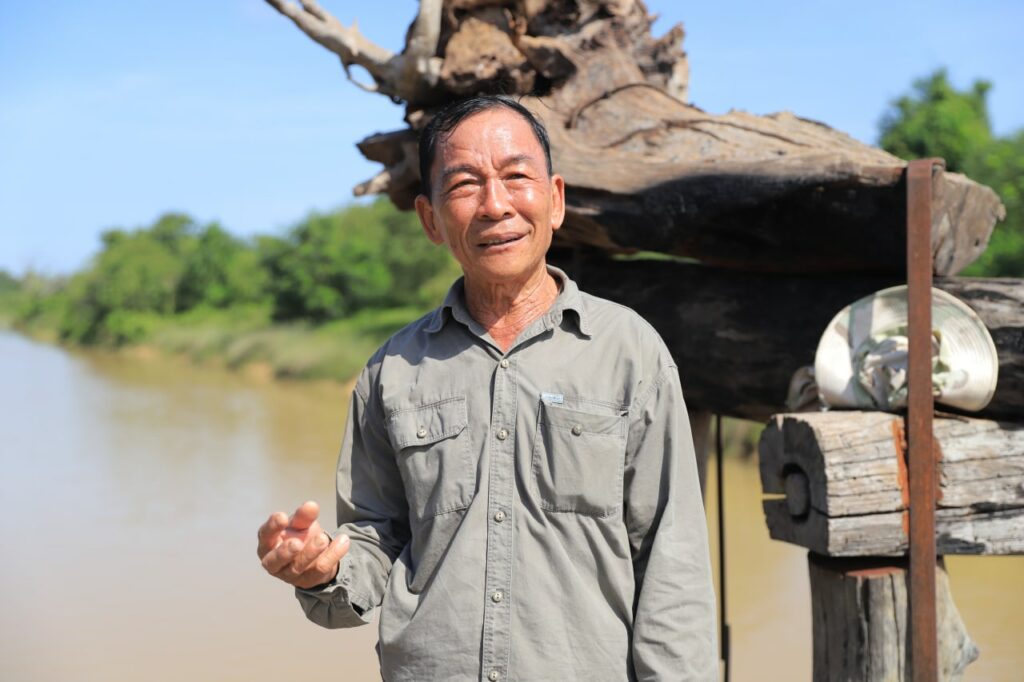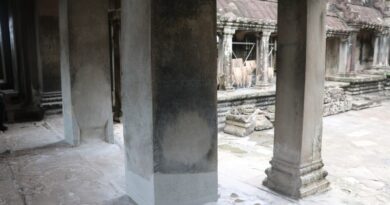Share Post:

នៅមុនឆ្នាំ២០១២ អាជ្ញាធរជាតិអប្សរា តាមរយៈអ្នកជំនាញផ្នែកទឹក បានរកឃើញប្រឡាយបុរាណមួយ ដែលអាចទាញទឹកពីភ្នំគូលែន ចូលមកក្នុងតំបន់រមណីយដ្ឋានអង្គរ។ នៅឆ្នាំ២០១២ គម្រោងស្ដារប្រឡាយនេះត្រូវបានដំណើរការ យ៉ាងណាការងារនេះត្រូវប៉ះពាល់លើដីប្រជាពលរដ្ឋកំពុងអាស្រ័យផលដំណាំជាក់ស្ដែង។
ដោយមានសំណើពីអាជ្ញាធរជាតិអប្សរា និងក្នុងបំណងរួមចំណែកធ្វើអ្វីសម្រាប់សង្គមជាតិផង លោក តាំង គ្រុយ បានសម្រេចផ្តល់ដីផ្ទាល់ខ្លួនរបស់លោកដែលកំពុងអាស្រ័យផល ឱ្យអាជ្ញាធរស្ដារប្រឡាយបុរាណ ក៏ដូចជាបង្កើតប្រភពទឹកខ្វាត់ខ្វែងនៅតំបន់នោះ។ លោក តាំង គ្រុយ បានរំឭកថា៖« ខ្ញុំគិតថា របស់ហ្នឹង [ដី] មិនមែនជារបស់បុគ្គលផ្តាច់មុខទេ ហើយដីយើងមានច្រើនដែរ គួរលះបង់ខ្លះដើម្បីប្រយោជន៍រួម ដើម្បីប្រទេសជាតិ និងសម្រាប់ដូនតាយើងដែលខំកសាងប្រាសាទមក ព្រោះតាមការឮពីចាស់ទុំមកថា អង្គរវត្តយើងគឺពឹងអាស្រ័យលើទឹក គ្រឹះប្រាសាទអង្គរវត្ត គឺដីខ្សាច់ ដូច្នេះបើគ្មានទឹកច្បាស់ជារលំជាមិនខាន»។
នៅឆ្នាំ២០១២ ពេលដែលអាជ្ញាធរជាតិអប្សរាចាប់ផ្តើមស្ដារប្រឡាយឡើងវិញ ដោយប្រឡាយនេះមានតួនាទីទទួលទឹកពីភ្នំគូលែន បំបែកទៅប៉ែកខាងលិច គឺស្ទឹងពួក ស្ទឹងព្រះស្រុក និងហូរចាក់ទៅទន្លេសាប។ ទឹកនេះក៏បានបញ្ចូលទៅបារាយណ៍ខាងជើង បារាយណ៍ខាងលិច កសិន្ធុអង្គរវត្ត និងកសិន្ធុអង្គរធំផងដែរ។ ប្រឡាយនេះមានប្រវែងជិត៥០គីឡូម៉ែត្រ។ អាជ្ញាធរជាតិអប្សរា បានសង់ទ្វារទឹកថ្មី ជំនួសស្ពានបុរាណ ដែលស្ថិតនៅខាងលើទ្វារទឹកតាសោម។
ការស្ដារនេះ គឺចាប់ពីផ្នែកខាងជើង កាត់ក្បាលដីលោក តាំង គ្រុយ កំពុងអាស្រ័យផល រហូតដល់ចុងដីនៅផ្នែកខាងត្បូង។ ទំហំដីដែលត្រូវស្ដារ ទំហំទទឹងប្រមាណ៥០ម៉ែត្រ និងបណ្ដោយ១ពាន់ម៉ែត្រ។ កាលណោះ លោក តាំង គ្រុយ មិនរំពឹងថា នឹងមានទឹកហូរហៀរដូចពេលនេះទេ ព្រោះថាកន្លងមកទីនោះ ជាដីគោក ដែលលោកដាំស្វាយចន្ទីពេញផ្ទៃដី។
មានវ័យ៦៩ឆ្នាំ លោក តាំង គ្រុយ ប្រាប់ថា ក្នុងនាមជាកសិករមួយរូប លោកពិតជារីករាយណាស់ ពេលឃើញទឹកសម្បូរបែបនេះ ដ្បិតកសិកម្ម គឺពឹងលើទឹក។ លោកនិយាយដោយទឹកមុខរីករាយយ៉ាងដូច្នេះថា៖« ដីដែលខ្សោះជីជាតិ អាចកែប្រែដាក់ជីបាន តែដីដែលខ្វះប្រភពទឹក គ្មានអ្នកណាជួយយើងបានទេ។ សប្បាយលើសពីសប្បាយធំបំផុត គឺយើងបានឈរលើស្ពានឃើញទឹកហូរ ហាក់ដូចបានត្រឡប់ទៅពេលវេលាអតីតកាល ព្រោះអ្នកប្រាជ្ញបានរកឃើញទីតាំងប្រភពទឹកបុរាណ ដែលកប់គ្មានអ្នកណាដឹង»។
ក្រោយមានប្រភពទឹកនៅកៀក លោក តាំង គ្រុយ បានចាប់ផ្តើមកែប្រែចម្ការរបស់លោក ដោយប្ដូរពីការដាំស្វាយចន្ទីរ មកដាំដំណាំហូបផ្លែផ្សេងៗ តែក្នុងនោះច្រើនជាងគេ គឺដូង។ បច្ចុប្បន្នលោកដាំដូងបានជាង២ពាន់ដើម និងមានគម្រោងដាំរហូតដល់១ម៉ឺនដើមនាពេលខាងមុខ។
ក្រៅពីអបអរជាមួយសមិទ្ធផលប្រឡាយទឹកខាងលើនេះ សប្បុរសជនដែលបានរួមចំណែកអភិវឌ្ឍន៍ប្រព័ន្ធទឹកក្នុងតំបន់រមណីយដ្ឋានអង្គរនេះ ក៏បានមើលឃើញពីការរីកចម្រើនជាបន្តបន្ទាប់របស់អាជ្ញាធរជាតិអប្សរានាពេលបច្ចុប្បន្នផងដែរ។ សម្រាប់លោក តាំង គ្រុយ ប្រជាពលរដ្ឋបានបង្ហាញការពេញចិត្តជាមួយអាជ្ញាធរជាតិអប្សរាកាន់តែខ្លាំងឡើង នៅពេលបានឃើញសមិទ្ធផល និងការទទួលបានផលទាំងនោះក្នុងមូលដ្ឋានពួកគេ ពិសេសប្រព័ន្ធទឹកតែម្ដង។ ប្រជាពលរដ្ឋមានទឹកស្រោចស្រពដំណាំ ចម្ការរបស់ពួកគេបានខួបប្រាំងវស្សា ដែលរួមចំណែកបង្កើនសេដ្ឋកិច្ចគ្រួសារពួកគេឱ្យកាន់តែរីកចម្រើនថែមទៀត៕
អត្ថបទ និងរូបភាព៖ នាង សំណាង
Farmer Taing Kruy to remind of handing his land to APSARA National Authority to restore the ancient canal in the Angkor site
Before 2012, the APSARA National Authority’s water experts discovered an ancient canal that could collect water from Phnom Kulen into the Angkor site. In 2012, the canal rehabilitation project was launched, however, this work would affect the land, and people who were living there.
At the request of the APSARA National Authority and to contribute to society, Mr. Taing Kruy decided to give his land to the APSARA to restore the ancient canal and create a water source in the area. Mr. Taing Kruy recalled: “I think that [land] does not belong to an exclusive person, and we have a lot of lands that should be sacrificed for the common good for the nation and for our ancestors who tried to build the temple because hearing from the elders that Angkor Wat depends on the sand foundation, so without water, it will collapse.”
In 2012, when the APSARA National Authority began to rehabilitate the canals for receiving water from Phnom Kulen, splitting it to the west, Stung Puok, Stung Preah Srok, and flowing into the Tonle Sap. The water also flows into the northern baray, the western baray, Angkor Wat’s moat, and Angkor Thom’s moat. The canal is nearly 50 kilometers long. The APSARA National Authority has built a new water gate to replace the old bridge above the Ta Som water gate.
This restoration was from the northern part through Mr. Taing Kruy’s land about 50 meters wide and 1,000 meters long to the southern part. At that time, He did not expect the water to overflow like now because in the past there was a land where he planted cashew nuts all over the land.
69-year-old Taing Kruy said that as a farmer he was very happy to see such abundant water because agriculture depends on water. He said with a happy face: “The soil that is not fertile can change to fertilize, but the soil that lacks water source, no one can help us. “More than just fun, we stood on the bridge and saw the water seem to go back to the past because the scholars found the location of the ancient water source buried without anyone knowing.”
After a water source nearby, Taing Kruy began to transform his plantation from cashew to other fruit crops, most of which were coconuts. So far, he has planted more than 2,000 coconut trees and planned to plant up to 10,000 in the future.
In addition to celebrating the achievement of the above ancient canal, the donors who have contributed to the development of the water system in the Angkor site, also see the continuous progress of the APSARA National Authority today. For Mr. Taing Kruy, the local people expressed their satisfaction with the APSARA, when they saw the achievements and the results in their local community, especially the water system. People have water to irrigate their fields in both seasons, which contributes to their family’s economic growth.
Article and Photos: Neang Samnang
Share:
Our Latest News

អាជ្ញាធរជាតិអប្សរាកំពុងអភិរក្ស និងជួសជុលជើងសសរនៅរួតបាកានប្រាសាទអង្គរវត្ត- APSARA National Authority is restoring pillars at the Bakan Tower, Angkor Wat- 05 June 2025
ក្រុមការងារនាយកដ្ឋានអភិរក្សប្រាសាទ និងបុរាណវិទ្យា នៃអាជ្ញាធរជាតិអប្សរា កំពុងអភិរក្ស និងជួសជុលជើងសសរនៅរួតបាកានប្រាសាទអង្គរ ដែលជើងសសរមួយចំនួនមានការពុកផុយ។



